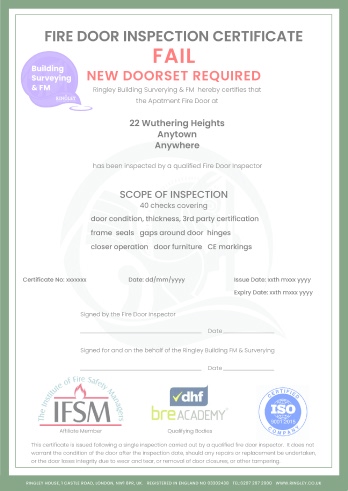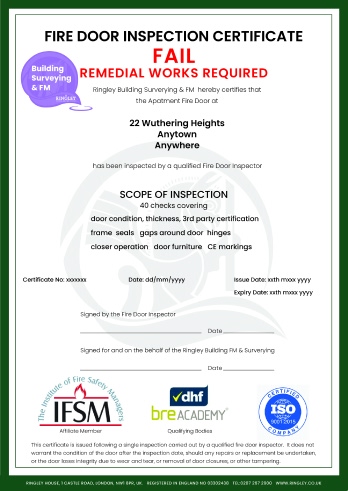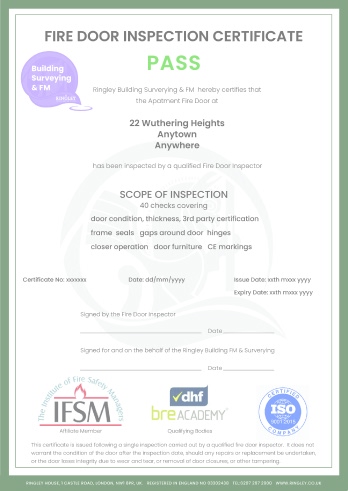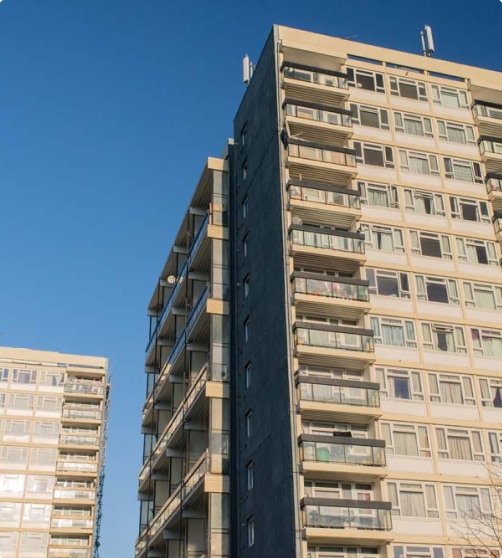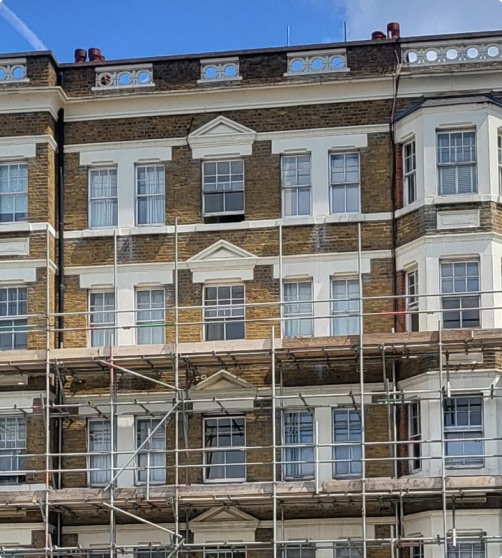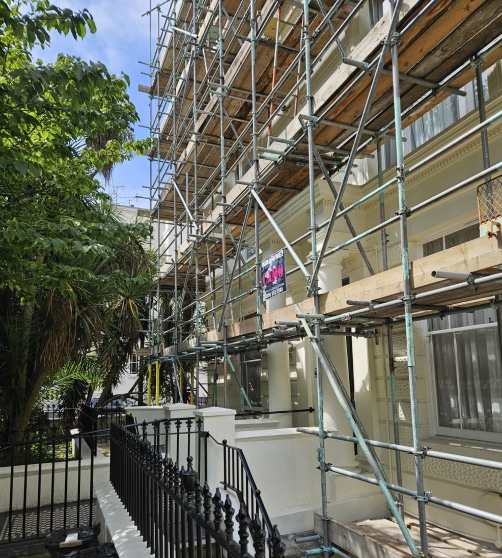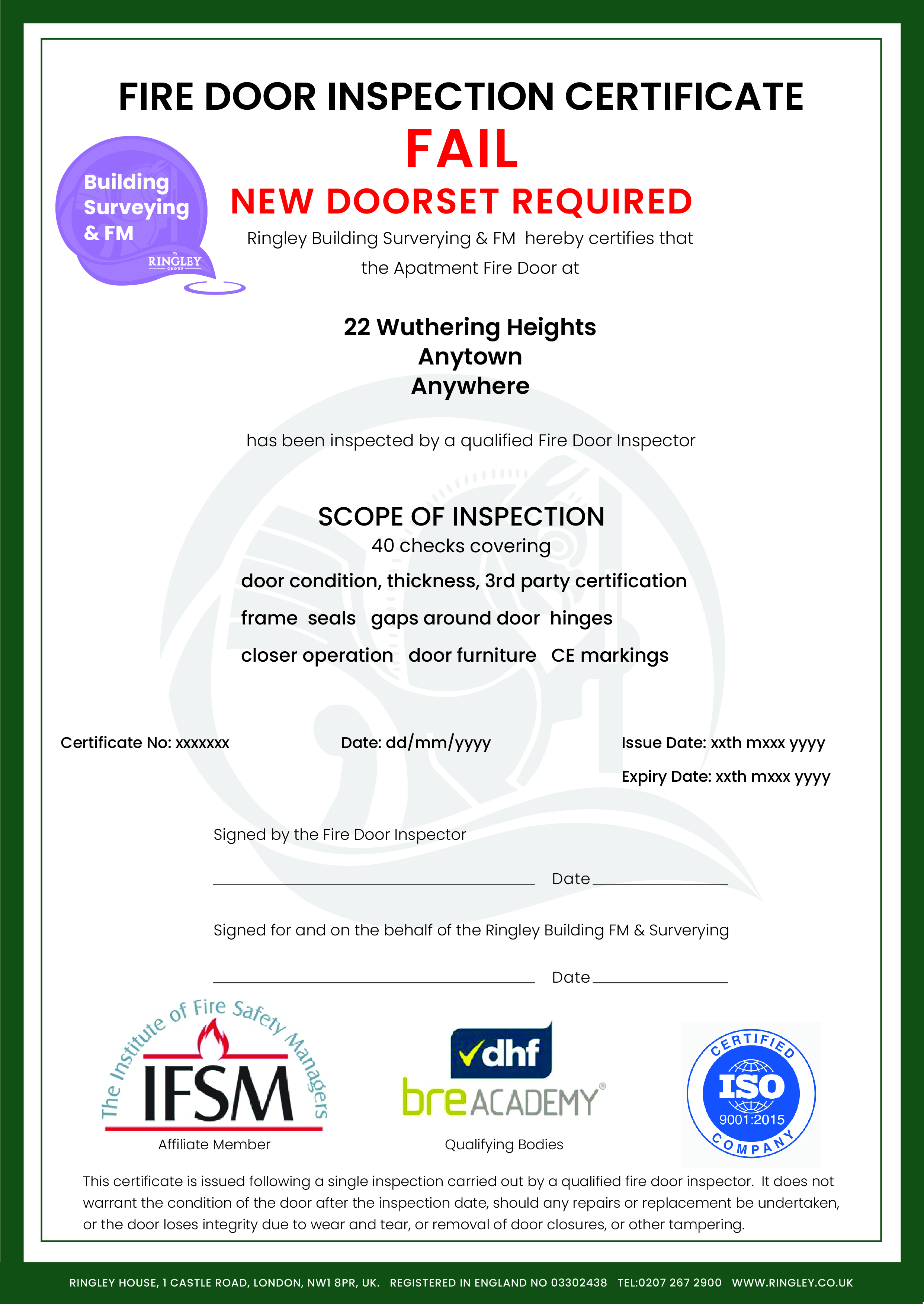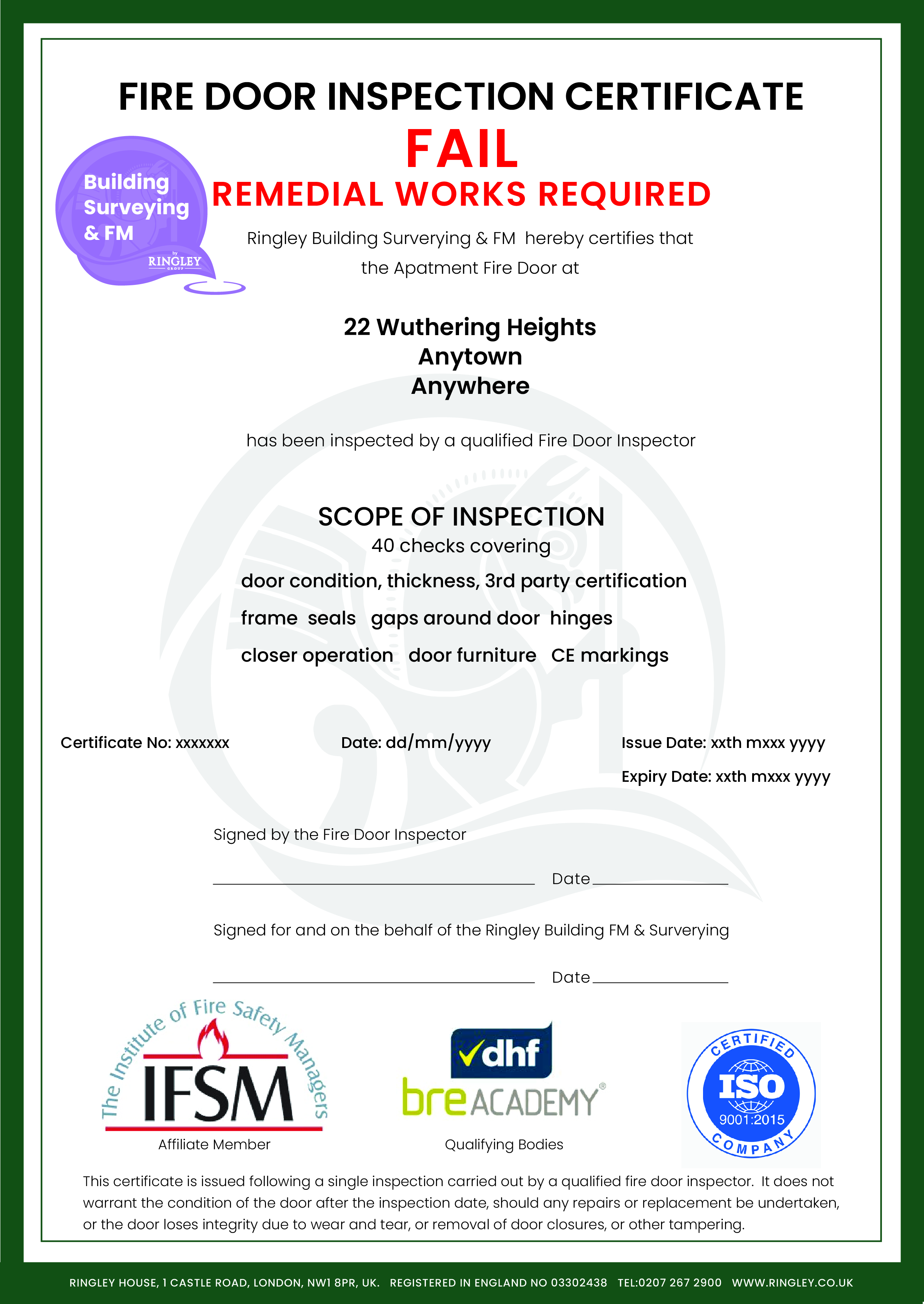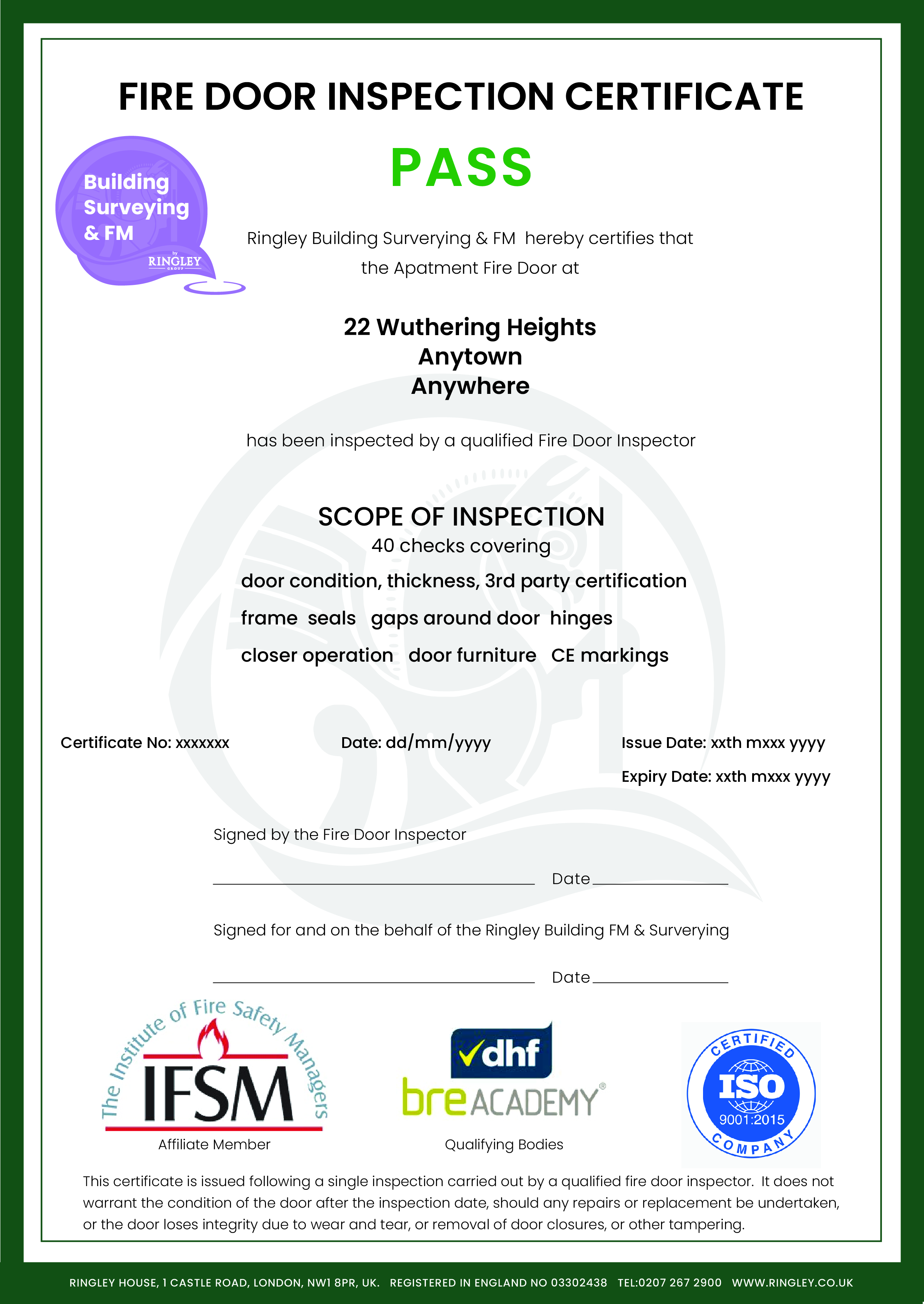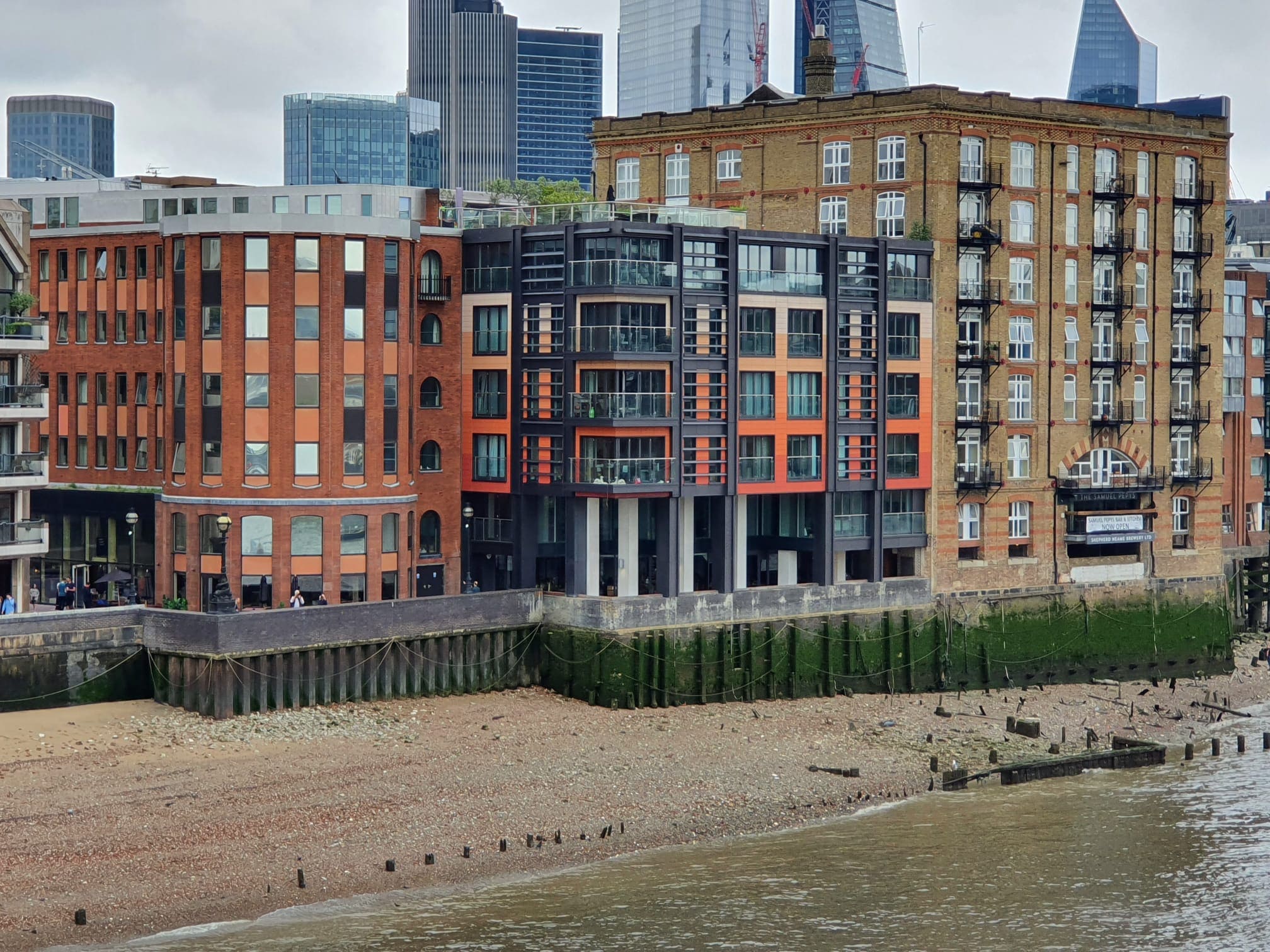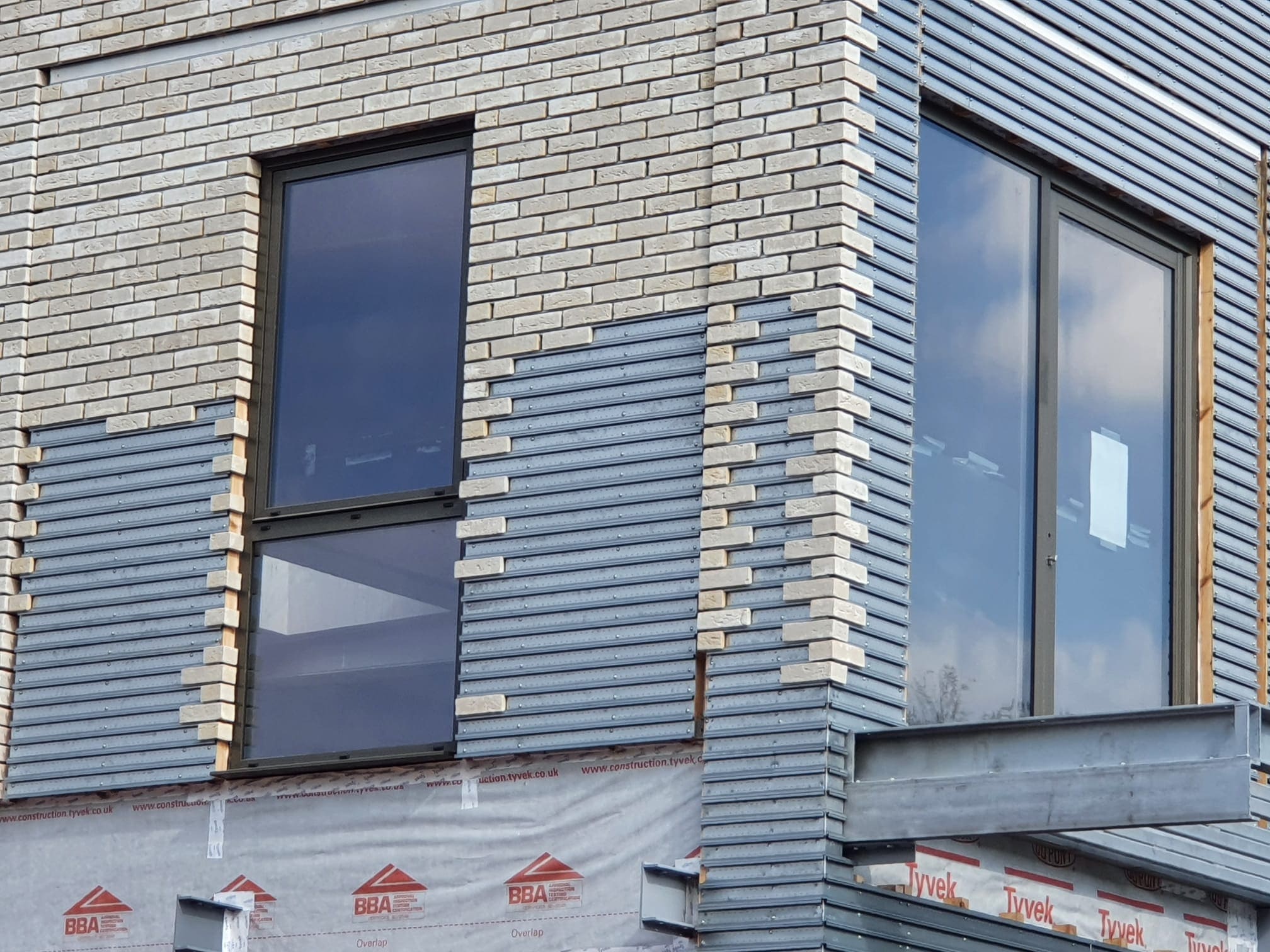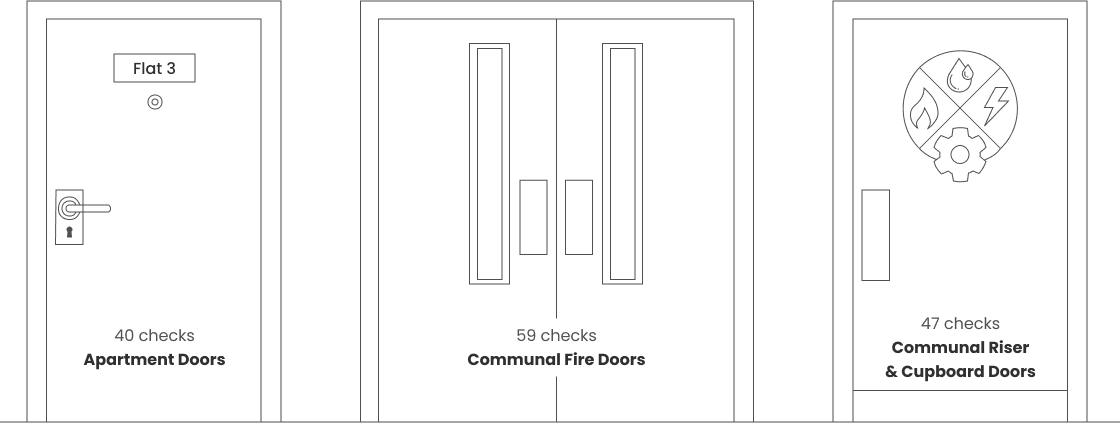
Typically the Fire Door Checks for Apartment front doors will include:
Does Fire Door have "Third Party Certified Fire Door" label or coding?
Door Resistance/Fire Rating (in minutes, i.e. FD30, FD60)?
Are the Fire Doors in good condition (if lipped are they glued, are there cracks or holes)?
Are the Fire Door Frames in good condition (firmly attached to walls, any gaps or failing seals, cracks and holes)?
What material are the Fire Door and frame made from?
What Type of Seals are in place?
Are Smoke Seals/Intumescent Strips in good condition (free from damage, paint and varnish, intumescent strips may still work if painted over)?
Does the door leaf have 3 or more hinges?
Are there loose or missing screws to the hinges?
Are hinges free of metal fragments, oil leakage, wear?
Are all other Ironmongery screws secure?
Other Ironmongery marked with CE stamp, BSEN 1935 grade 13?
Other ironmongery free from damage and operating correctly?
Is a Door Closer Fitted?
Is the Door Closer in good condition (attached to door frame, no oil leakage)?
Does the Fire Door fully close and shut tight by use of its own Self Closing Device (up to 25 seconds to close)?
Top: Gaps compliant (2 - 4 mm)
Hinge Side: Gaps compliant (2 - 4 mm)
Opening Side: Gaps compliant (2 - 4 mm)
Bottom: Gaps compliant (3 - 8 mm)
Is there glazing in the Fire Door and/or surrounding Frame?
Is the glazing Fire Rated?
Is the glazing in good condition in the Fire Door and/or Frame (loose, damaged, cracked)?
Is the seal continuous around the beading and beading secure?
Typically the Fire Door Checks for Apartment front doors will include:
Does Fire Door have "Third Party Certified Fire Door" label or coding?
Door Resistance/Fire Rating (in minutes, i.e. FD30, FD60)?
Are the Fire Doors in good condition (if lipped are they glued, are there cracks or holes)?
Are the Fire Door Frames in good condition (firmly attached to walls, any gaps or failing seals, cracks and holes)?
What material are the Fire Door and frame made from?
Are "Fire Door Keep Shut" signs displayed to both sides of the Fire Doors?
What Type of Seals are in place?
Are Smoke Seals/Intumescent Strips in good condition (free from damage, paint and varnish, intumescent strips may still work if painted over)?
Does the door leaf have 3 or more hinges?
Are there loose or missing screws to the hinges?
Are hinges free of metal fragments, oil leakage, wear?
Are all other Ironmongery screws secure?
Other Ironmongery marked with CE stamp, BSEN 1935 grade 13?
Other ironmongery free from damage and operating correctly?
Is a Door Closer Fitted?
Is the Door Closer in good condition (attached to door frame, no oil leakage)?
Does the Fire Door fully close and shut tight by use of its own Self Closing Device (up to 25 seconds to close)?
Top: Gaps compliant (2 - 4 mm)
Hinge Side: Gaps compliant (2 - 4 mm)
Opening Side: Gaps compliant (2 - 4 mm)
Bottom: Gaps compliant (3 - 8 mm)
Is there glazing in the Fire Door and/or surrounding Frame?
Is the glazing Fire Rated?
Is the glazing in good condition in the Fire Door and/or Frame (loose, damaged, cracked)?
Is the seal continuous around the beading and beading secure?
Are the Fire Doors Automatic or Manual?
If Automatic Fire Doors are in Place, are "Automatic Fire Door Keep Clear" signs displayed?
Is there a Door Hold Open Mechanism?
Are Fire Doors Wedged Open?
Can the Fire Door be opened without the use of a key?
Does the Fire Door open in the direction of travel to the fire exit?
Are Door Handles in place?
If glazing panels are below 1500mm, is glass safety glass?
Are door handles loose or missing?
Typically the Fire Door Checks for Apartment front doors will include:
Does Fire Door have "Third Party Certified Fire Door" label or coding?
Door Resistance/Fire Rating (in minutes, i.e. FD30, FD60)?
Are the Fire Doors in good condition (if lipped are they glued, are there cracks or holes)?
Are the Fire Door Frames in good condition (firmly attached to walls, any gaps or failing seals, cracks and holes)?
Are "Fire Door Keep Locked Shut" signs displayed to Riser Fire Doors?
What Type of Seals are in place?
Are Smoke Seals/Intumescent Strips in good condition (free from damage, paint and varnish, intumescent strips may still work if painted over)?
Does the door leaf have 3 or more hinges?
Are hinges free of metal fragments, oil leakage, wear?
Are all other Ironmongery screws secure?
Other Ironmongery marked with CE stamp, BSEN 1935 grade 13?
Other ironmongery free from damage and operating correctly?
Top: Gaps compliant (2 - 4 mm)
Hinge Side: Gaps compliant (2 - 4 mm)
Opening Side: Gaps compliant (2 - 4 mm)
Bottom: Gaps compliant (3 - 8 mm)
Is there glazing in the Fire Door and/or surrounding Frame?
Is the glazing Fire Rated?
Is the glazing in good condition in the Fire Door and/or Frame (loose, damaged, cracked)?
Is the seal continuous around the beading and beading secure?
Can the Fire Door be opened without the use of a key?
Types of Fire Door Inspection Certificates
Your Fire Door Inspector should issue you with a Certificate and a copy of the fire door inspection report as backup. The Fire Door Certificate issued will either PASS or FAIL your door. If your fire door fails its fire door inspection then it may need minor remedial works, or a new fire door, or a new doorset (which means new fire door and frame).
At Ringley we issue 4 types of Fire Door Inspection Certificates:
- PASS
- FAIL - Remedial Works
- FAIL - New Door Required
- FAIL - New Doorset Required
How to interpret your Fire Door Inspection Report
As part of the Building Regulations application and sign off process every building has to have a fire strategy document. So what is a Fire Strategy Document?
First understand the Fire Strategy Document
A Fire Strategy Document explains how the building is constructed in terms of fire resisting materials, as well as the level of fire protection that needs to be afforded by each component of the building structure: walls, floors, ceilings, doors etc... It then specifies the fire rating of materials to be used to meet the standard of fire rating required.
Second, see what the Fire Door Inspection Report says
A Fire Door Inspection Report effectively checks that all the parts of the fire door still maintain the originally designed level of integrity or protection from fire (and smoke). The smoke seals are hugely important as smoke kills long before an actual fire will. Fire doors must self-close properly into their frame as they protect one compartment from another. A fire door inspection comprises 40 checks: these range from checking the doors thickness to its combustibility, the gaps around its edges and at the threshold, the seals, hinges, door closers and checking how the ironmongery is fitted.
Whilst the FIre Door Inspection report reports on the fire door, on its own, the fire door inspection report alone may not be enough - it needs to be considered in conjunction with the fire strategy document. This is particularly important in more complex buildings as the fire door inspection report results should be intepreted and benchmaked against the fire strategy document; for example: a fire door inspection PASS for an FD30s door is no good if, the fire strategy document said an FD60s should have been fitted.
What is the difference between an FD30s vs FD60s explained
An FD30s is a 'F' fire, 'D' door, '30' that offers 30 minutes protection and has 's' smoke seals. So an FD60s - simply offers 60 minutes protection.
What you can do if the wrong type of fire door is installed
Having a FD30s installed, when the fire strategy document says an FD60s should have been installed, is definitely something you should take up with the housebuilder or developer. THis just got easier as The Building Safety Act 2022 provides protection going back retrospectively 30 years for fire safety faults. Installing the wrong door to what the fire strategy document says would definitely be something to pursue, some other faults raised on the fire door inspection may well also be 'developer issues', but not faults due to 'wear and tear'.
Where to find the fire strategy document for your building
The fire strategy document for your building, may be in the O&M (Operation & Maintenance) Manuals. Otherwise, it can be requested from the developer who to comply with Section 38 of the Building Regulations must provide it.
Top tips to think about before instructing your Fire Door Inspections
Before you instruct your fire door inspections you should check if the reports issued by the fire door inspector will
- include a review of the fire strategy document
- identify which faults are original install faults as opposed to wear and tear
The risks of not getting your fire doors inspected explained
If you don't get your fire doors inspected and there was a fire, and your fire door had lost integrity due to wear and tear, or suffered from 'original developer installation faults' and failed to adequately fulfil its job of compartmentalising the fire, lives would be endangered, and could be lost. In such instance it is a certainty that any post fire investigation would require sight of the Fire Door Inspection Certificates for the building, along with evidence that any remedial works recommended were carried out. If fire door inspection certificates and records of remedial works could not be produced then it is highly likely the Responsible Person would be prosecuted.
Fire door remedial works: who pays what
The demise of an Apartment generally includes the front door. Under the Fire Safety Act 2021 the duty to carry out fire door inspections becomes a service charge cost, but not remedial works. Remedial works remain the Owners responsibility and cost. The logic being that most repairs are 'wear and tear' therefore caused by the Owner.
How to go about getting fire door repairs done
Firstly, you need to share the Fire Door Inspection Reports with the Owners, and best to do so with an advice note on why repairs are so important, how to find the right accredited contractor to fix things and explain what could happen if fire door faults are not repaired.
What can be done if an owner does not resolve issues with their fire door
Serve a Section 38 Repairs Notice
Report the outstanding works to the Council Enforcement Department
Report the outstanding works to the Fire Service
Apply to the Court for an order for Specific Performance
Court or Tribunal action to confirm breach and/or Section 146 forfeiture action

Ultimately, what happens if an Owner does not put their fire door right...
As not acting to address fire door faults could endanger the lives of others and leave an intended compartment of the building unsatisfactory, the Fire Service may require a 'waking watch' to be put in place. This would be 24 hours a day and could be a huge cost to the service charge. In this context calling in the authorities seems less unreasonable as everyone has a duty to act responsibly in matters of fire safety.
Repairs to fire doors as a communal repair programme
Many blocks decide to run programmes to change all fire doors as a communal programme and ask owners to opt in. The obvious benefits are:
- bulk buyers discount
- all doors sourced and supplied by same manufacturer
- professional tendering, administration and running of the contract
- end of job retention for the 6 months defects period
However, it is less simple for fire door repairs as 'wear and tear' repairs will be different for different apartments so recharging the cost of repairs to each in proportion to works done on their apartment is essential.
Considerations: how to present fire door faults to the developer
The reason it is important to ensure that your Fire Door Inspector identifies original install faults is that there may well be an opportunity to present such faults to the developer for rectification, and/or, to make a new build warranty claim. Since Michael Gove took charge of the Levelling Up Agenda and drove through the Fire Safety Act 2021, (which widened the scope and regime for fire door inspections), and the Building Safety Act 2022, (which extended limitation periods to enable leaseholders to claim for fire safety related faults potentially going backwards 30 years), if your Fire Door Inspector, or the Fire Door Inspection App that they use is clever enough to quantify original developer install faults from wear and tear' faults, like ours is, then your Fire Door Inspector should leave you with several very useful outputs:
- A PASS or FAIL Certificate for each door/property
- A digital inspection report for each door/property/block
- A Bill of Quantities listing all faults and where they occur in an easy ready to price format
- A Bill of Quantities listing original developer install faults
- A Bill of Quantities listing wear and tear faults
If you receive all this then you will be equipped for all eventualities, e.g., to serve papers on Owners to repair their own doors, to run a bulk programme to deal with all faults as a communal issue or to make an NHBC claim, or new build warranty claim, or to present a Building Safety Act 2022 claim against the developer.
The steps in tendering fire door remedial works are:
Contract Administration is the term used to cover the work involved when a Chartered Surveyor or Chartered Engineer plans, specifies, tenders and then administers the form of contract for a building works project in this case fire doors.
On site administration
Consider necessary permissions
Specification & tendering the works
Pre-start probity checks & contracts
If service charge monies are to be used - start consulting

Lessehold challenges - Beware of improvements
Most older leases do not provide for improvements to be recovered as service charges. On communal as opposed to demised areas, a lease will usually provide for works related to statute and by-laws which should cover most fire related works.
The Ringley Fire Door Inspection Complete Toolkit
So, given there are Fire Door Inspections Apps and there are Fire Door Inspectors out there but there are very few solutions that deal which deliver all of the following:
- Uploading owners/residents names for Apartment door inspections
- Managing fire door inspection bookings
- Issuing no show fines
- Providing PASS / FAIL Certificates
- Individual Reports per Apartment
- Grouped Reports per Block or Site
- Bill of Quantities
- Full Tender pack
- Digital transparent tendering process
- Bulk Procurement of Works
- Portal for Owners to submit [upload] proof of remedial works done
- Mechanism for Engineers to check works for adequacy
- Diary to schedule next regime of inspections
- Ringley Law to serve Section 38 Repairs Notices to call for works not done
- Preparation of evidence to support developer claims under the Building Safety Act 2022
- Preparation of evidence to support NHBC and new build warranty claims
Related Articles
Building Safety act becomes law as more developers sign the building safety pledge contract
FAQ
What is does the FD certification mean?
- FD20 - 20 minute fire door
- FD20s - 20 minute fire door with smoke seal
- FD30 - 30 minute fire door
- FD30s - 30 minute fire door with smoke seal
- FD60 - 60 minute fire door
- FD60s - 60 minute fire door with smoke seal
A qualified Fire Door Inspector will make up to 59 checks on each fire door - the diagram below demonstrates how many fire door checks there are for each type of door.
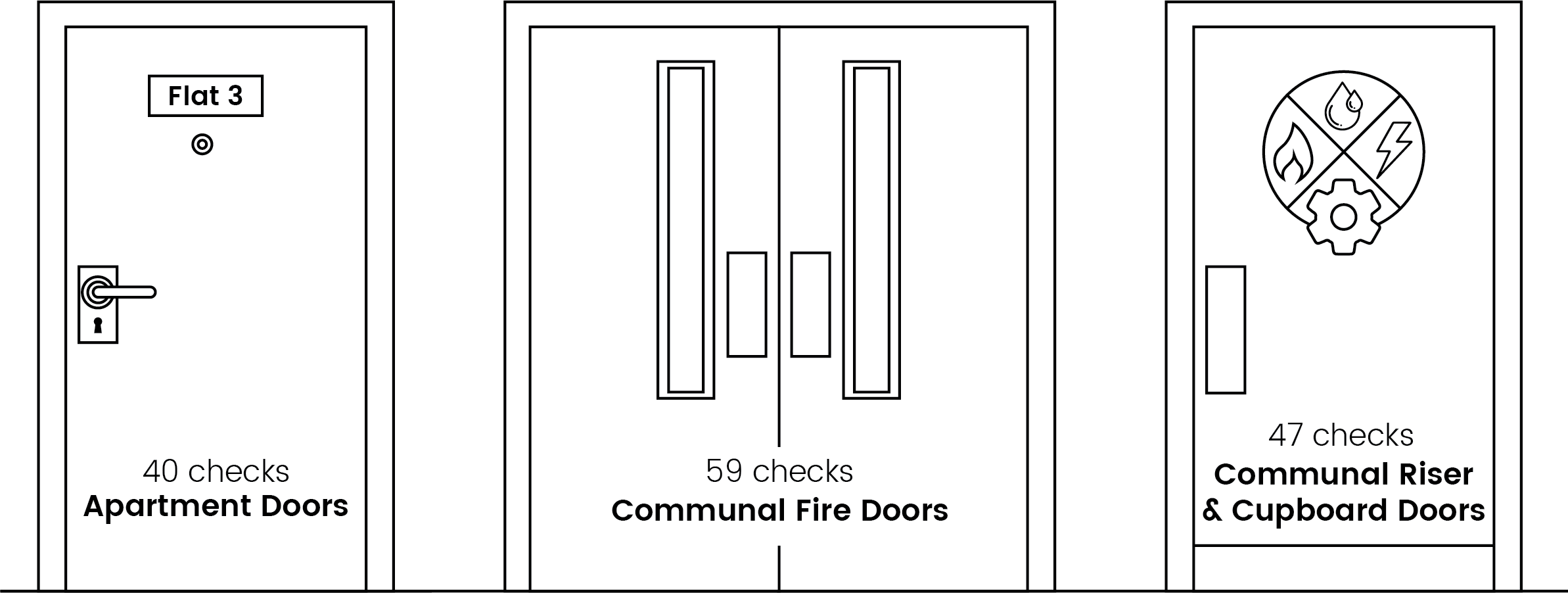
| Apartment Door Checks | Communal Fire Door Checks | Riser Cupboard Door Checks |
|---|
Types of Fire Door Inspection Certificates
Your Fire Door Inspector should issue you with a Certificate and a copy of the fire door inspection report as backup. The Fire Door Certificate issued will either PASS or FAIL your door. If your fire door fails its fire door inspection then it may need minor remedial works, or a new fire door, or a new doorset (which means new fire door and frame).
At Ringley we issue 4 types of Fire Door Inspection Certificates:
- PASS
- FAIL - Remedial Works
- FAIL - New Door Required
- FAIL - New Doorset Required
How to interpret your Fire Door Inspection Report
As part of the Building Regulations application and sign off process every building has to have a fire strategy document. So what is a Fire Strategy Document?
First understand the Fire Strategy Document
A Fire Strategy Document explains how the building is constructed in terms of fire resisting materials, as well as the level of fire protection that needs to be afforded by each component of the building structure: walls, floors, ceilings, doors etc... It then specifies the fire rating of materials to be used to meet the standard of fire rating required.
Second, see what the Fire Door Inspection Report says
A Fire Door Inspection Report effectively checks that all the parts of the fire door still maintain the originally designed level of integrity or protection from fire (and smoke). The smoke seals are hugely important as smoke kills long before an actual fire will. Fire doors must self-close properly into their frame as they protect one compartment from another. A fire door inspection comprises 40 checks: these range from checking the doors thickness to its combustibility, the gaps around its edges and at the threshold, the seals, hinges, door closers and checking how the ironmongery is fitted.
Whilst the FIre Door Inspection report reports on the fire door, on its own, the fire door inspection report alone may not be enough - it needs to be considered in conjunction with the fire strategy document. This is particularly important in more complex buildings as the fire door inspection report results should be intepreted and benchmaked against the fire strategy document; for example: a fire door inspection PASS for an FD30s door is no good if, the fire strategy document said an FD60s should have been fitted.
What is the difference between an FD30s vs FD60s explained
An FD30s is a 'F' fire, 'D' door, '30' that offers 30 minutes protection and has 's' smoke seals. So an FD60s - simply offers 60 minutes protection.
What you can do if the wrong type of fire door is installed
Having a FD30s installed, when the fire strategy document says an FD60s should have been installed, is definitely something you should take up with the housebuilder or developer. THis just got easier as The Building Safety Act 2022 provides protection going back retrospectively 30 years for fire safety faults. Installing the wrong door to what the fire strategy document says would definitely be something to pursue, some other faults raised on the fire door inspection may well also be 'developer issues', but not faults due to 'wear and tear'.
Where to find the fire strategy document for your building
The fire strategy document for your building, may be in the O&M (Operation & Maintenance) Manuals. Otherwise, it can be requested from the developer who to comply with Section 38 of the Building Regulations must provide it.
Top tips to think about before instructing your Fire Door Inspections
Before you instruct your fire door inspections you should check if the reports issued by the fire door inspector will
- include a review of the fire strategy document
- identify which faults are original install faults as opposed to wear and tear
The risks of not getting your fire doors inspected explained
If you don't get your fire doors inspected and there was a fire, and your fire door had lost integrity due to wear and tear, or suffered from 'original developer installation faults' and failed to adequately fulfil its job of compartmentalising the fire, lives would be endangered, and could be lost. In such instance it is a certainty that any post fire investigation would require sight of the Fire Door Inspection Certificates for the building, along with evidence that any remedial works recommended were carried out. If fire door inspection certificates and records of remedial works could not be produced then it is highly likely the Responsible Person would be prosecuted.
Fire door remedial works: who pays what
The demise of an Apartment generally includes the front door. Under the Fire Safety Act 2021 the duty to carry out fire door inspections becomes a service charge cost, but not remedial works. Remedial works remain the Owners responsibility and cost. The logic being that most repairs are 'wear and tear' therefore caused by the Owner.
How to go about getting fire door repairs done
Firstly, you need to share the Fire Door Inspection Reports with the Owners, and best to do so with an advice note on why repairs are so important, how to find the right accredited contractor to fix things and explain what could happen if fire door faults are not repaired.
What can be done if an owner does not resolve issues with their fire door
-
Serve a Section 38 Repairs Notice
This formally calls for the required works to be completed within a specified time period, perhaps 60 days would be reasonable. The costs of such notice would be recharged to the leaseholder as a schedule 11 Administration Charge under the Commonhold & Leasehold Reform Act 2022.
-
Report the outstanding works to the Council Enforcement Department
The Local Authority has enforcement powers over the demise of an apartment. They can exercise their powers as apartment entrance doors ordinarily form part of the demise. If an owner does not comply with an enforcement notice then they can be fined.
-
Report the outstanding works to the Fire Service
The Fire Service has enforcement powers over the common parts (onto which the apartment door closes and seals the compartment). They can exercise their powers as the integrity of apartment entrance doors forms an essential part of the communal hallway compartmentation.If an owner does not comply with an enforcement notice then they can be fined.
-
Apply to the Court for an order for Specific Performance
An order for Specific Performance is just that - it means the Court will order the party in default to do the works. Court costs and legal fees will be recharged to them too.
-
Court or Tribunal action to confirm breach and/or Section 146 forfeiture action
Forfeiture is the process whereby the landlord forfeits a lease. It is triggered by S146 of the Law of Property Act. There has tp be a serious breach for forfeiture to be possible and a Court or Tribunal must determine there is a breach before the process can get underway.
Ultimately, what happens if an Owner does not put their fire door right...
As not acting to address fire door faults could endanger the lives of others and leave an intended compartment of the building unsatisfactory, the Fire Service may require a 'waking watch' to be put in place. This would be 24 hours a day and could be a huge cost to the service charge. In this context calling in the authorities seems less unreasonable as everyone has a duty to act responsibly in matters of fire safety.
Repairs to fire doors as a communal repair programme
Many blocks decide to run programmes to change all fire doors as a communal programme and ask owners to opt in. The obvious benefits are:
- bulk buyers discount
- all doors sourced and supplied by same manufacturer
- professional tendering, administration and running of the contract
- end of job retention for the 6 months defects period
However, it is less simple for fire door repairs as 'wear and tear' repairs will be different for different apartments so recharging the cost of repairs to each in proportion to works done on their apartment is essential.
Considerations: how to present fire door faults to the developer
The reason it is important to ensure that your Fire Door Inspector identifies original install faults is that there may well be an opportunity to present such faults to the developer for rectification, and/or, to make a new build warranty claim. Since Michael Gove took charge of the Levelling Up Agenda and drove through the Fire Safety Act 2021, (which widened the scope and regime for fire door inspections), and the Building Safety Act 2022, (which extended limitation periods to enable leaseholders to claim for fire safety related faults potentially going backwards 30 years), if your Fire Door Inspector, or the Fire Door Inspection App that they use is clever enough to quantify original developer install faults from wear and tear' faults, like ours is, then your Fire Door Inspector should leave you with several very useful outputs:
-
A PASS or FAIL Certificate for each door/property
-
A digital inspection report for each door/property/block
-
A Bill of Quantities listing all faults and where they occur in an easy ready to price format
-
A Bill of Quantities listing original developer install faults
-
A Bill of Quantities listing wear and tear faults
If you receive all this then you will be equipped for all eventualities, e.g., to serve papers on Owners to repair their own doors, to run a bulk programme to deal with all faults as a communal issue or to make an NHBC claim, or new build warranty claim, or to present a Building Safety Act 2022 claim against the developer.
The steps in tendering fire door remedial works are:
Contract Administration is the term used to cover the work involved when a Chartered Surveyor or Chartered Engineer plans, specifies, tenders and then administers the form of contract for a building works project in this case fire doors.
-
If service charge monies are to be used - start consulting
- There are up to 3 stages of statutory consultation that must be served, before service charge monies can be spent on 'works', else recoverability of the cost of the works may be restricted to 250 per owner
- For larger projects, the Health & Safety Executive may have to be notified
-
Consider necessary permissions
On larger or complex projects, the Construction (Design and Management) Regulations (CDM), are likely to apply. CDM Regulations require various duty holders to be appointed and require specific documentation to ensure Health and Safety is considered from initial design, right through completion and ongoing maintenance beyond.
-
Specification & tendering the works
With Ringley for half the price of normal contract administration we will convert all the individual fire door inspections into a bill of quantities. This means the role of Contract Administrator is reduced as we pre-prepare the tender pack. The fire door remedial works tender pack includes:
- Tender front cover
- The specified rectification for each fault
- The Bill of Quantities: detailing how many of each type of fault and to which door
- Schedule of workmanship & materials
- Tender collection page
-
Pre-start probity checks & contracts
Probity checks before letting a fire door installation or remedial works contract will include checking the contractor ihas cashflow to bank roll the project between valuations, holds the necessary fire door installer accreditations, as well as that accounts and references are up to date.
Contract terms will have to address an area to store materials, damages for contract over-run, and agreeing the works programme.
-
On site administration
This stage of administering a contract means periodic inspections to sample materials delivered to site, workmanship sample inspected are right, as well as giving directions to determine the way forward on any issues that may arise during the contract. Works done are valued at various stages; this is a formal process whereby payment certificates trigger interim payments, and, this continues up to the issue of the final practical completion certificate. Practical completion signifies the end of works on site, and kicks off the 6 months defects liability period. Usually 2.5% of the contract sum is retained for the defects liability period, and, after the 6 months defects period ends, the contract administrator considers what is due and releases the retention.
Lessehold challenges - Beware of improvements
Most older leases do not provide for improvements to be recovered as service charges. On communal as opposed to demised areas, a lease will usually provide for works related to statute and by-laws which should cover most fire related works.
The Ringley Fire Door Inspection Complete Toolkit
So, given there are Fire Door Inspections Apps and there are Fire Door Inspectors out there but there are very few solutions that deal which deliver all of the following:
-
Uploading owners/residents names for Apartment door inspections
-
Managing fire door inspection bookings
-
Issuing no show fines
-
Providing PASS / FAIL Certificates
-
Individual Reports per Apartment
-
Grouped Reports per Block or Site
-
Bill of Quantities
-
Full Tender pack
-
Digital transparent tendering process
-
Bulk Procurement of Works
-
Portal for Owners to submit [upload] proof of remedial works done
-
Mechanism for Engineers to check works for adequacy
-
Diary to schedule next regime of inspections
-
Ringley Law to serve Section 38 Repairs Notices to call for works not done
-
Preparation of evidence to support developer claims under the Building Safety Act 2022
-
Preparation of evidence to support NHBC and new build warranty claims
Related Articles
Building Safety act receives royal assentBuilding Safety act becomes law as more developers sign the building safety pledge contract
FAQ
What is does the FD certification mean?
- FD20 - 20 minute fire door
- FD20s - 20 minute fire door with smoke seal
- FD30 - 30 minute fire door
- FD30s - 30 minute fire door with smoke seal
- FD60 - 60 minute fire door
- FD60s - 60 minute fire door with smoke seal
